Xerocomus Quél.
Recent molecular studies have shown that Xerocomus in its current circumscription is likely an artificial grouping and it is possible that it will be split at some point into smaller genera. Molecular studies also have changed our understanding about the species of xerocomoid boletes showing that morphological features are quite variable in this group. Not only microscopic study is essential for determination, but scanning electron microscope will be often needed in this “genus” as the spore ornamentation is not always seen under ordinary light microscope. Do bear in mind that macroscopic characters, such as colours, cracking cuticle, etc., tend to intergrade between the different species. Note that Boletus impolitus and Boletus depilatus that were shown to be close to Xerocomus subtomentosus and its allies, are here retained in Boletus for practical reasons. The same applies also for Phylloporus pelletieri, placed here in a genus of its own, but being also close to Xerocomus subtomentosus group.
Although large reference list will be found under most of the species, one should always consult Ladurner & Simonini (2003) having in mind that there are some new species (X. chrysonemus, X. marekii, X. silwoodensis) described after this otherwise superior book was printed. Useful keys, covering most of the European xerocomoid boletes (except some southern taxa) are provided by Knudsen & Vesterholt (2008), Hills (2008) and Kibby (2011), the later also featuring an excellent comparison chart.
Fruitbody medium to small sized, boletoid, without veil and ring. Stipe solid, often tapering towards the base. Flesh variously coloured, changing or not when exposed to air. Tubes not separable from each other, instead tearing apart. Pores usually angular.
Xerocomus moravicus (Vacek) Herink
Description
Cap up to 7 cm, at first hemispherical, later convex to flattened, ochraceous, yellow brown to coppery brown, dry, velvety, sometimes finely cracked. Stipe cylindrical, ventricose or club-shaped, almost concolorus with the cap or a bit paler, often with darker network-like pattern. Tubes ochraceous yellow to yellow, not blueing when injured. Pores concolorous with the tubes or sometimes spotted brownish or orange, not blueing when bruised. Flesh whitish, ochraceous or brownish above the tubes and below the cap cuticle, unchanging when exposed to air. Smell fine, somewhat of coconut. Taste not distinctive. Spores 10–13 × 4.5–6.5 μm, smooth. Pileipellis palisadoderm of septate hyphae of cylindrical not or slightly incrusted cells.
Habitat. Warm broadleaf forests, mycorrhizal with oaks (Quercus), sweet chestnut (Castanea), hornbeam (Carpinus) or lime (Tilia).
Distribution. Recorded in many European countries, but apparently more common in south.
Similarity. Similar to Xerocomus subtomentosus. Distinguished by the white and uniformly coloured in the stipe flesh as well as by its wide spores. Compare also to Xerocomus badius that has mostly different colours and blueing flesh.
Note. Xerocomus leonis is considered a synonym.
Photographs
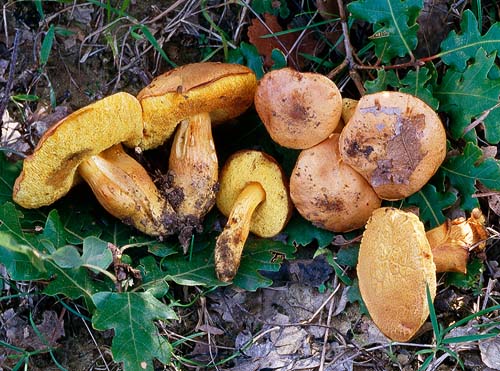
Rich collection of Xerocomus moravicus. The difference of the stature of the fruitbodies is notable - from xerocomoid to nearly boletoid. (photo G. Konstantinidis)
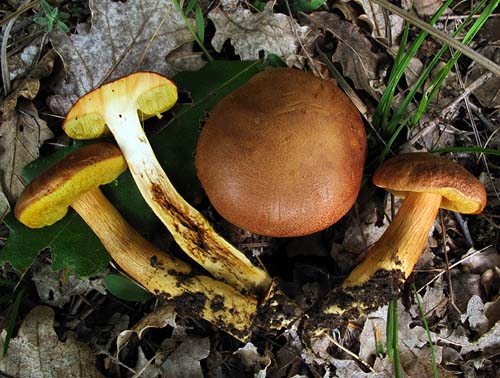
Fruitbodies of Xerocomus moravicus. The orange brown to cinnamon colour of the flesh under the cap cuticle is peculiar feature of the species. (photo G. Konstantinidis)
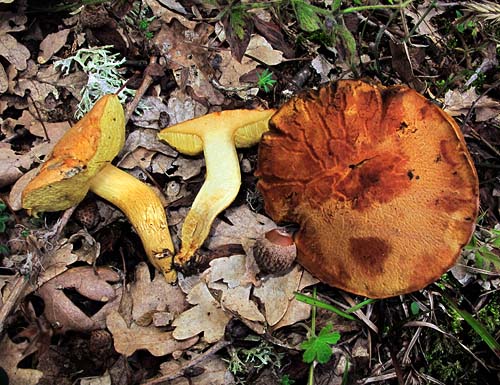
Frutibodies of Xerocomus moravicus. (photo G. Konstantinidis)

Fruitbody of Xerocomus moravicus. (photo B. Assyov)
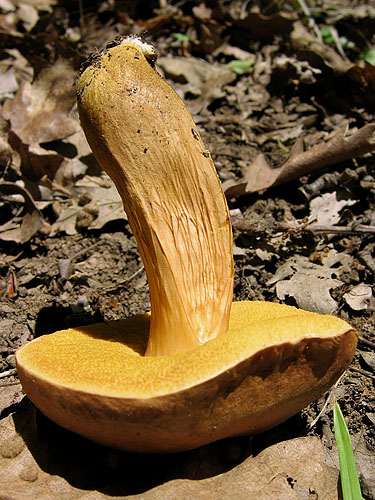
Fruitbody of Xerocomus moravicus. (photo B. Assyov)
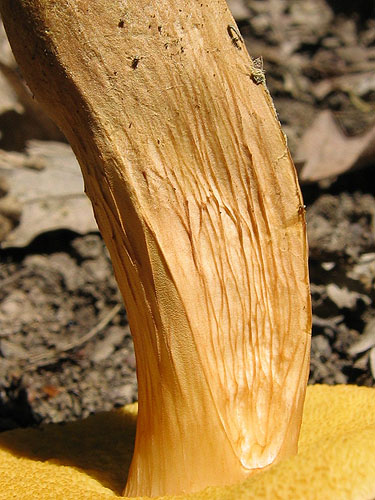
Xerocomus moravicus - detail of the stipe surface. (photo B. Assyov)
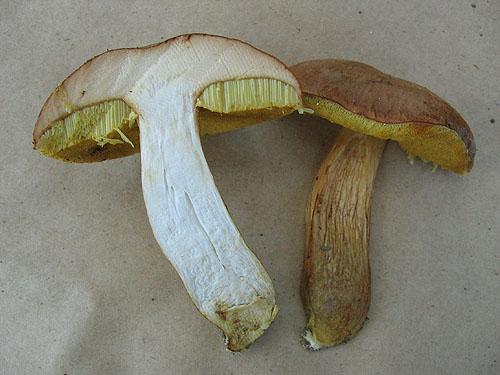
Xerocomus moravicus. Note again the colour of the flesh beneath the cap cuticle. (photo B. Assyov)
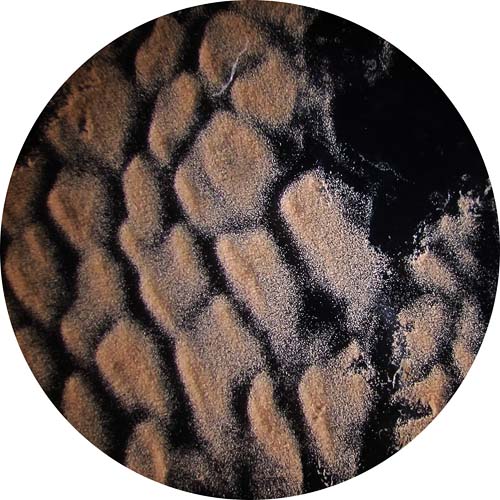
Spore print of Xerocomus moravicus under magnification. (photo G. Konstantinidis)
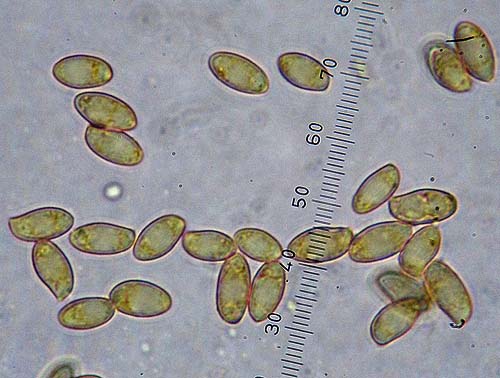
Spores of Xerocomus moravicus. These are broad and pale coloured and characteristic for this species. (photo G. Konstantinidis)
Important literature
Alessio, C.L. 1985. Boletus Dill. ex L. (sensu lato). – In: Fungi Europaei. Vol. 2. Pp. 1–705. Libreria editrice Biella Giovanna, Saronno.
Engel, H., Dermek, A., Klofac, W., Ludwig, E. & Brückner, T. 1996. Schmier – und Filzröhrlinge s. l. in Europa. Die Gattungen Boletellus, Boletinus, Phylloporus, Suillus, Xerocomus. Verlag Heinz Engel, Weidhausen b. Coburg.
Estadès, A. & Lannoy, G. 2004. Les bolets européens. – Bulletin Mycologique et Botanique Dauphiné-Savoie 44(3): 3–79.
Galli, R. 1998. I Boleti. Atlante pratico-monographico per la determinazione dei boleti. Edinatura, Milano.
Ladurner, H. & Simonini, G. 2003. Xerocomus s.l. – In: Fungi Europaei. Vol. 8. Pp. 1–527. Edizioni Candusso, Alassio.
Lannoy, G. & Estadès, A. 2001. Les Bolets. Flore mycologique d’Europe. Documents Mycologiques Mémoire Hors série no. 6. Pp. 1–163. Association d’Écologie et de Mycologie, Lille.
Pöder, R. 1991. Xerocomus leonis (Reid) Bon ist Xerocomus moravicus (Vacek) Herink. – Rivista di Micologia 33: 298–305.
Šutara, J., Mikšík, M. & Janda, V. 2009. Hřibovité houby. Čeled’ Boletaceae a rody Gyrodon, Gyroporus, Boletinus a Suillus. Academia, Praha.
Watling, R. & Hills, A.E. 2005. Boletes and their allies (revised and enlarged edition). – In: Henderson, D.M., Orton, P.D. & Watling, R. [eds]. British Fungus Flora. Agarics and boleti. Vol. 1. Royal Botanic Garden, Edinburgh.